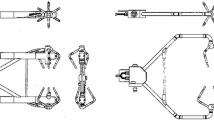Summary
Wind data collected during the Great Plains Turbulence Field Experiment of 1953 are used to study the relative performances of various types of cup anemometers subjected to air flow of known gustiness. Scatter diagrams which relate differences in the indicated mean speeds of two anemometers to gustiness are prepared. Although the instruments compared represent a wide range of moments of inertia, no relationship between gustiness and anemometer performance is noted. This result is examined in light of Schrenk's parameter which describes anemometer performance.
Zusammenfassung
Windbeobachtungen, welche während des “Great Plains Turbulence Field Program” im Jahre 1953 gewonnen wurden, werden zu einem Vergleich verschiedener Typen von Schalenkreuzanemometern in einem Windfeld von bekannter Böigkeit verwendet. Die Ergebnisse werden in Form von Streubildern veranschaulicht, in denen die Geschwindigkeits-unterschiede von verschiedenen Anemometern als Funktion des Böigkeitsgrades aufgetragen sind. Obgleich die verglichenen Anemometer erheblich verschiedene Trägheitsmomente besitzen, ergibt sich keine Abhängigkeit der Anzeigedifferenzen von der Böigkeit des Windes. Dieser Befund wird mit Hilfe des Schrenkschen Parameters näher beleuchtet.
Résumé
Les observations anémométriques effectuées dans le cadre du “Great Plains Turbulence Field Program” en 1953 sont utilisées ici dans le but de comparer différents types d'anémomètres à cupules placés dans un champ de mouvement de turbulence connue. Les résultats sont donnés sous forme d'essaims de points dans un système de référence: écarts individuels de l'indication et degré de turbulence. Bien que les instruments comparés présentent des moments d'inertie notablement différents, les écarts observés ne dépendent pas de la turbulence du vent. Ce résultat est encore examiné à l'aide du paramètre de Schrenk.
Similar content being viewed by others
References
Cramer, H. E., G. C. Gill, andF. A. Record: Heated-Thermocouple Anemometers and Light Bivanes. Sect. 5. 2. 1 of “Exploring the Atmosphere's First Mile”, Vol. 1. New York: Pergamon Press (1957).
Deacon, E. L.: Gust Variation with Heights up to 150 Meters. Quart. J. Roy. Met. Soc.81, 562 (1955).
Lettau, H. H., andB. Davidson: Exploring the Atmosphere's First Mile. Two Volumes. New York: Pergamon Press (1957).
—: Computation of Richardson Numbers, Classification of Wind Profiles, and Determination of Roughness Parameters. Sect 7.4 of “Exploring the Atmosphere's First Mile”, Vol. 1. New York: Pergamon Press (1957).
Middleton, W. E. K., andA. F. Spilhaus: Meteorological Instruments, p. 143–147. Toronto: University of Toronto Press (1953).
Sanuki, M.: Pap. Met. Geophys., Tokyo3, 115 (1952).
Schrenk, O.: Über die Trägheitsfehler des Schalenkreuz-Anemometers bei schwankender Windstärke. Techn. Phys.10, 57 (1929).
Sheppard, P. A.: An Improved Design of Cup Anemometer. J. Sci. Instr.17, 218 (1940).
Author information
Authors and Affiliations
Additional information
With 4 Figures
Rights and permissions
About this article
Cite this article
Horn, L.H. The relative performance of various cup anemometers in a gusty wind. Arch. Met. Geoph. Biokl. B. 9, 231–237 (1958). https://doi.org/10.1007/BF02242910
Issue Date:
DOI: https://doi.org/10.1007/BF02242910




